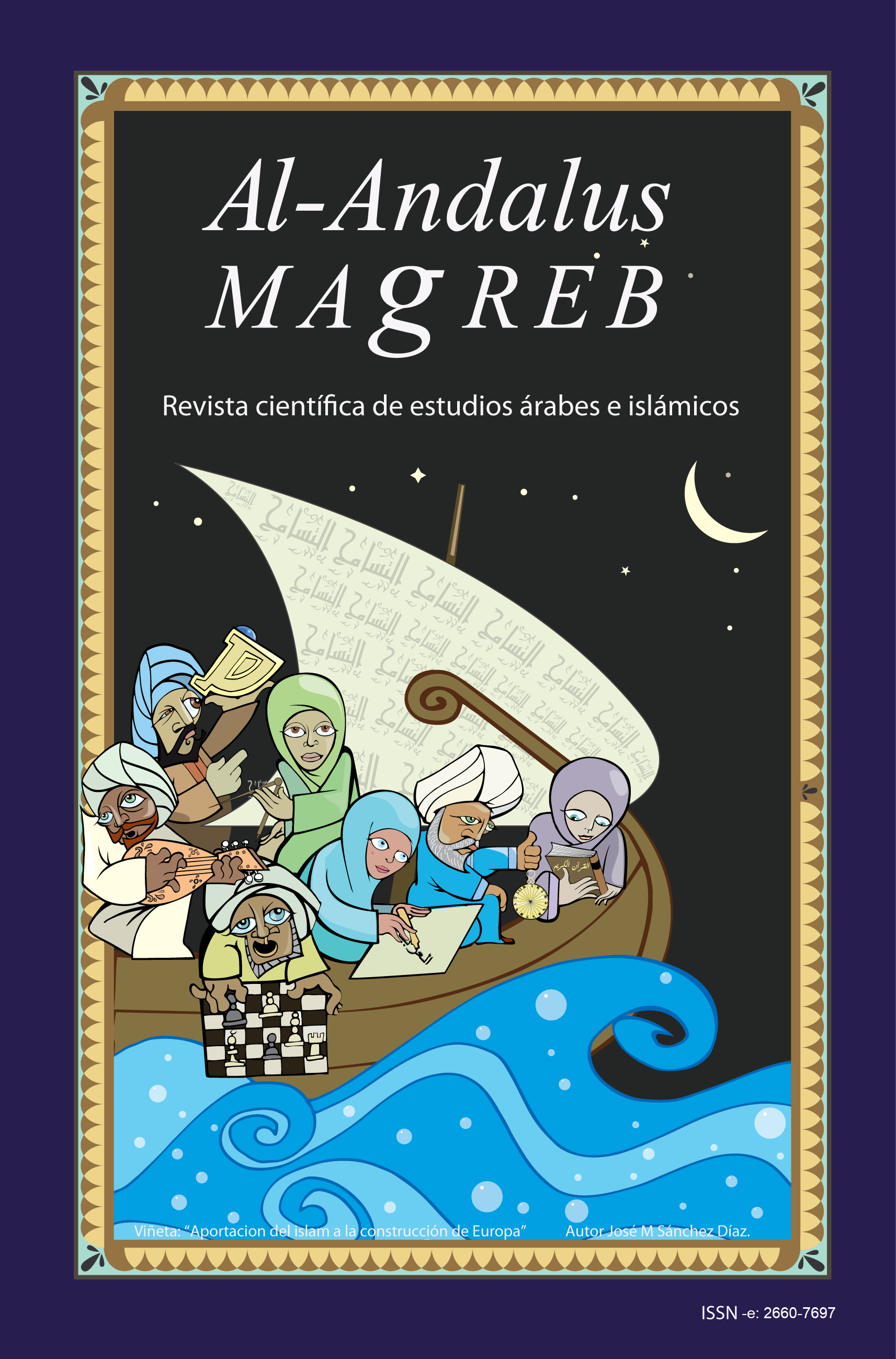Visibilisation of the Amazigh in Alberto Ruy Sánchez's Los jardines secretos de Mogador (The Secret Gardens of Mogador)

Downloads
- PDF (Español (España)) 208
- EPUB (Español (España)) 83
- VISOR (Español (España))
- MOVIL (Español (España))
- XML (Español (España)) 82
DOI
https://doi.org/10.25267/AAM.2022.i23.06Info
Abstract
The work aims to study the mode of representation of the Berber in Los jardines secretos de Mogador. As specific objectives, we first seek the determination of the historical-epistemological circumstances that marked the Amazig memory in a multiple superstructure of power and hegemony. Then we try to stand out the agency of various narrative resources of the work studied to make the amazig visible. Through an analytical-comparative approach we want to arrive at the verification of the hypothesis that in the peripheral literary model of Alberto Ruy Sánchez, particularly and in a general Latin American way, flashes of a heterarchical and horizontal vision of the Berber are outlined. The study tries to demonstrate that the literary exploration of what is common to the two peoples, the Latin American-Mexican and the Moroccan-Amazig, are the architects of an alternative gnosis. Elements such as oral memory, the hybrid recreation of components of the artistic, literary and artisan legacy of both cultures allow us to overcome the subalternizing essentialism of canonical orientalist representations. The obvious conclusion of the work is that literary discourse can be the best instrument for destabilizing the empire of the imaginary of domination.
Keywords
Downloads
How to Cite
License

This work is licensed under a Creative Commons Attribution-NonCommercial-NoDerivatives 4.0 International License.
Those authors who have publications with this journal, accept the following terms:
a. Authors may retain their copyright and guarantee the journal the right of first publication of their work, which will be simultaneously subject to Licencia de reconocimiento de Creative Commons that allows third parties to share the work as long as its author is indicated. and its first publication this journal.
b. Authors may adopt other non-exclusive license agreements for the distribution of the version of the published work (eg: deposit it in an institutional electronic file) provided that the initial publication in this journal is indicated.
c. Authors are allowed and recommended to disseminate their work through the Internet (eg: in institutional telematic files or on their website) once the manuscript is accepted, which can lead to interesting exchanges and increase citations of the published work. (See El efecto del acceso abierto).
References
ʾIBN ḪALDŪN, ʿabd al-Rraḥmān (2002): Al-ʿibar wa dīwān al-mubtadaʾ wa al-ḫabar fī ayāmi al-ʿarab wa al-ʿaǧam wa al-barbar wa man ʿāṣarahum men ḏawī al-ssulṭāni al-ʾakbar. Amán: Bayt al-ʾafkār al-Dawliya.
AILLET, Cyrille (2011) : «Islamisation et arabisation dans le monde musulman médiéval: une introduction au cas de l'Occident musulman (VIIe-XIIe siècle)», En Islamisation et arabisation de l’Occident musulman médiéval (VIIe-XIIe siècle), de Dominique Valérian (éd.), Paris: Publications de la Sorbonne, pp. 7-34.
BARTHES, Roland (1987): «La muerte del autor» En El susurro del lenguaje, de Roland Barthes, Barcelona: Paidós, pp. 65-71.
BAUMAN, Zygmunt (2005): Vidas desperdiciadas: la modernidad y sus parias, Buenos Aires: Paidós.
BAUMAN, Zygmunt (2015): Modernidad líquida, Buenos Aires: Fondo de Cultura Económica.
BAYART, Jean-François (1996): L’illusion identitaire, Paris: Fayard.
BERNABÉ LÓPEZ GARCÍA, Bernabé (1990): «Arabismo y orientalismo en España: radiografía y diagnóstico de un gremio escaso y apartadizo», Awraq XI, pp. 35-69.
BHABHA, Homi (2002): El lugar de la cultura, Buenos Aires: Manantial.
CHAKER, Salem (1986): «Amaziɣ (le/un Berbère)» Encyclopédie berbère [En ligne], mis en ligne le 01 décembre 2012. Último acceso: 24 diciembre 2021. http://journals.openedition.org/encyclopedieberbere/2465, DOI : https://doi.org/10.4000/encyclopedieberbere.2465
DE SOUSA SANTOS, Boaventura (2010): Descolonizar el saber, reinventar el poder, Montevideo: Ediciones Trilce.
DE SOUSA SANTOS, Boaventura (2018): «Una nueva visión de Europa: aprender del Sur global.» En Demodiversidad: imaginar nuevas posibilidades democráticas, de Boaventura de Sousa Santos & José Manuel Mendes (eds.), México: Akal, pp. 59-92.
DELEUZE, Gilles, & GUATTARI, Félix (1977): «Rizoma», En Mil mesetas, Gilles Deleuze & Félix Guattari, Valencia: Pretextos, pp. 9-29
ECO, Umberto (1987): La estrategia de la ilusión. Buenos Aires: Lumen.
ECO, Umberto (1992): Obra abierta. Forma e indeterminación en el arte contemporáneo, Barcelona: Planeta-De Agostini.
FOUCAULT, Michel. (1979): Microfísica del poder, Madrid: La Piqueta.
GARCÍA CANCLINI, Néstor (1989): Culturas híbridas: estrategias para entrar y salir de la modernidad, México: Grijalbo.
HALL, Stuart (2010): «Occidente y el resto: discurso y poder», En Discurso y Poder en Stuart Hall, de Ricardo Soto Sulca (ed.), Huancayo: Universidad Nacional del Centro de Perú, pp. 49-113.
LESAGE, Jean Michel (1999): «Gnawa », Encyclopédie berbère [en linea]. Último acceso: 8 de junio de 2021. http://journals.openedition.org/encyclopedieberbere/1739; https://doi.org/10.4000/encyclopedieberbere.
LOYTARD, Jean-François (1987): La condición posmoderna. Informe sobre el saber, Madrid: Cátedra.
MARIA DELGADO DE CANTÚ, Gloria (2002): Historia de México Vol. 1, México: Editorial Pearson Educación.
RAMA, Ángel (2008): Transculturación narrativa en América Latina, Buenos Aires: El Andariego.
ROUIGHI, Ramzi (2019): Inventing the Berbers: History and Ideology in the Maghrib, Pennsylvania: University of Pennsylvania Press.
RUY SÁNCHEZ, Alberto (2001): Los Jardines secretos de Mogador: voces de la tierra [edición electrónica], México: Alfaguara.
RUY SÁNCHEZ, Alberto (2001): «Por un orientalismo horizontal», Artes de México 55, pp. 31-38.
SAID, Edward (2004): Cultura e Imperialismo, Barcelona: Editorial Anagrama.
SAID, Edward (2008): Orientalismo, Barcelona: Debolsillo.
SPIVAK, Gayatri Chakravorty (1985): «Three women's texts and a critique of imperialism», Critical Inquiry 12 (1), pp. 243-261.
SPIVAK, Gayatri Chakravorty (2010): Crítica de la razón poscolonial: hacia una crítica del presente evanescente, Madrid: Akal.
TODOROV, Tzvetan (2008): El miedo a los bárbaros: más allá del choque de civilizaciones, Barcelona: Galaxia Gutenberg/Círculo de Lectores.





